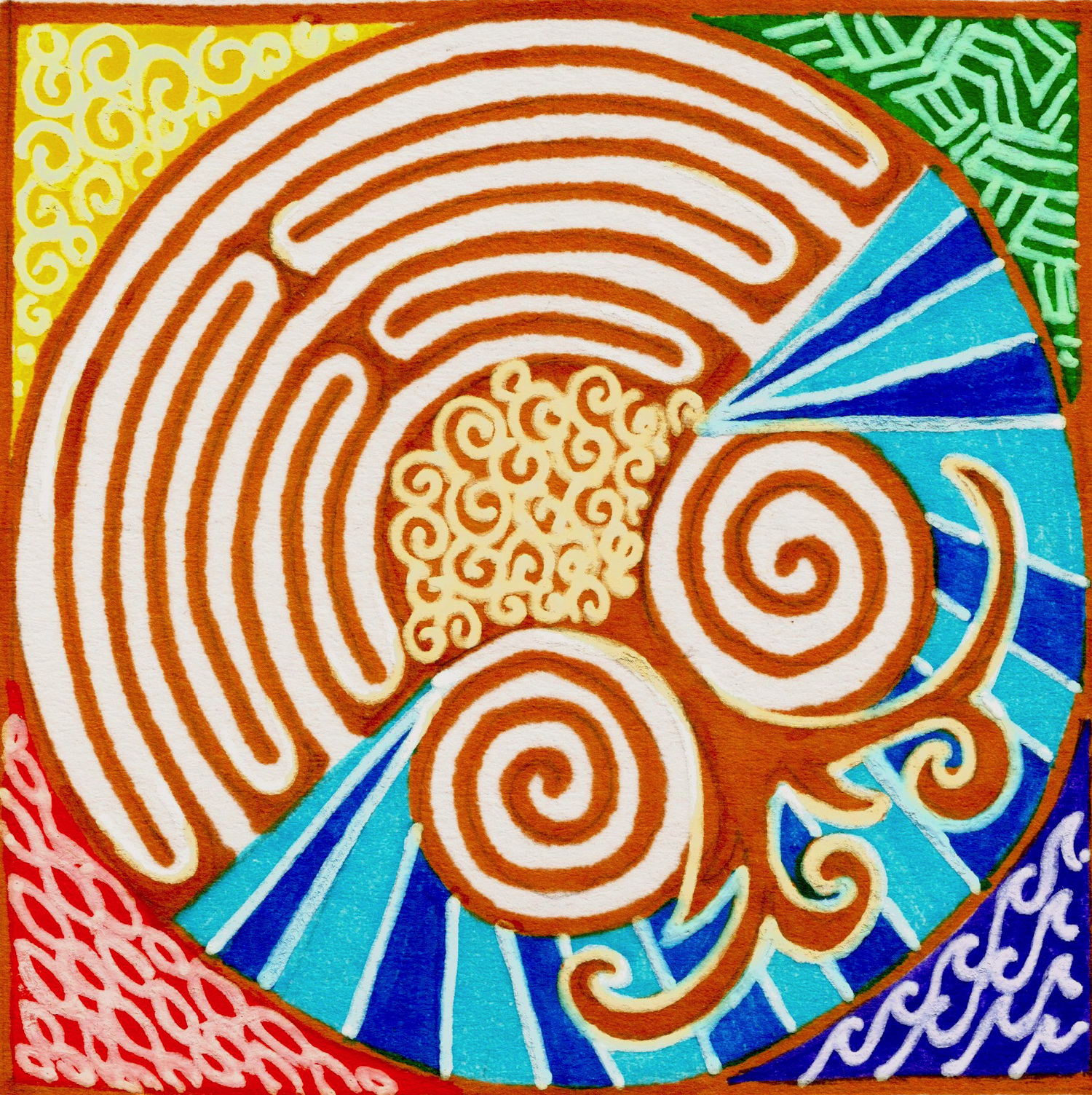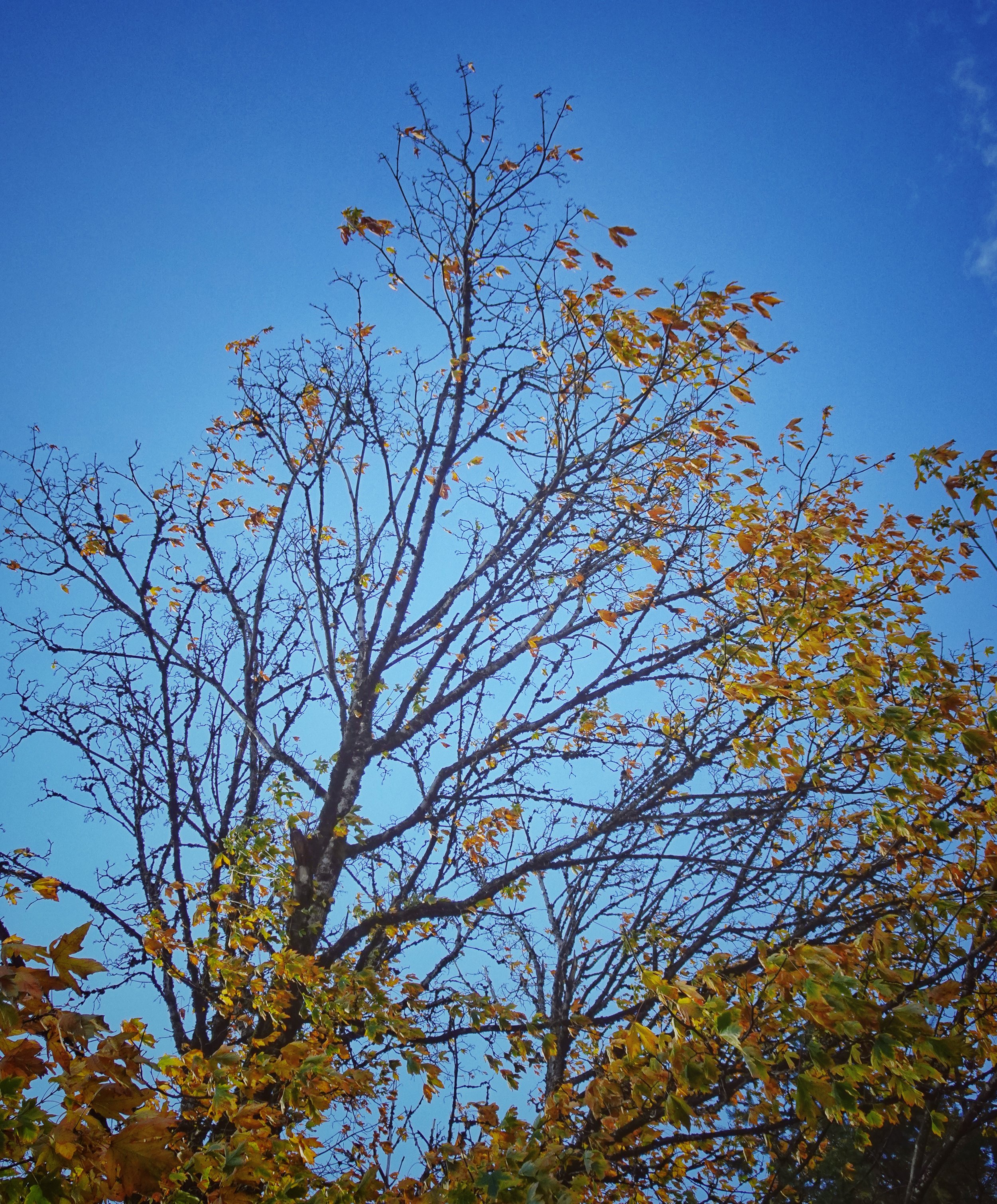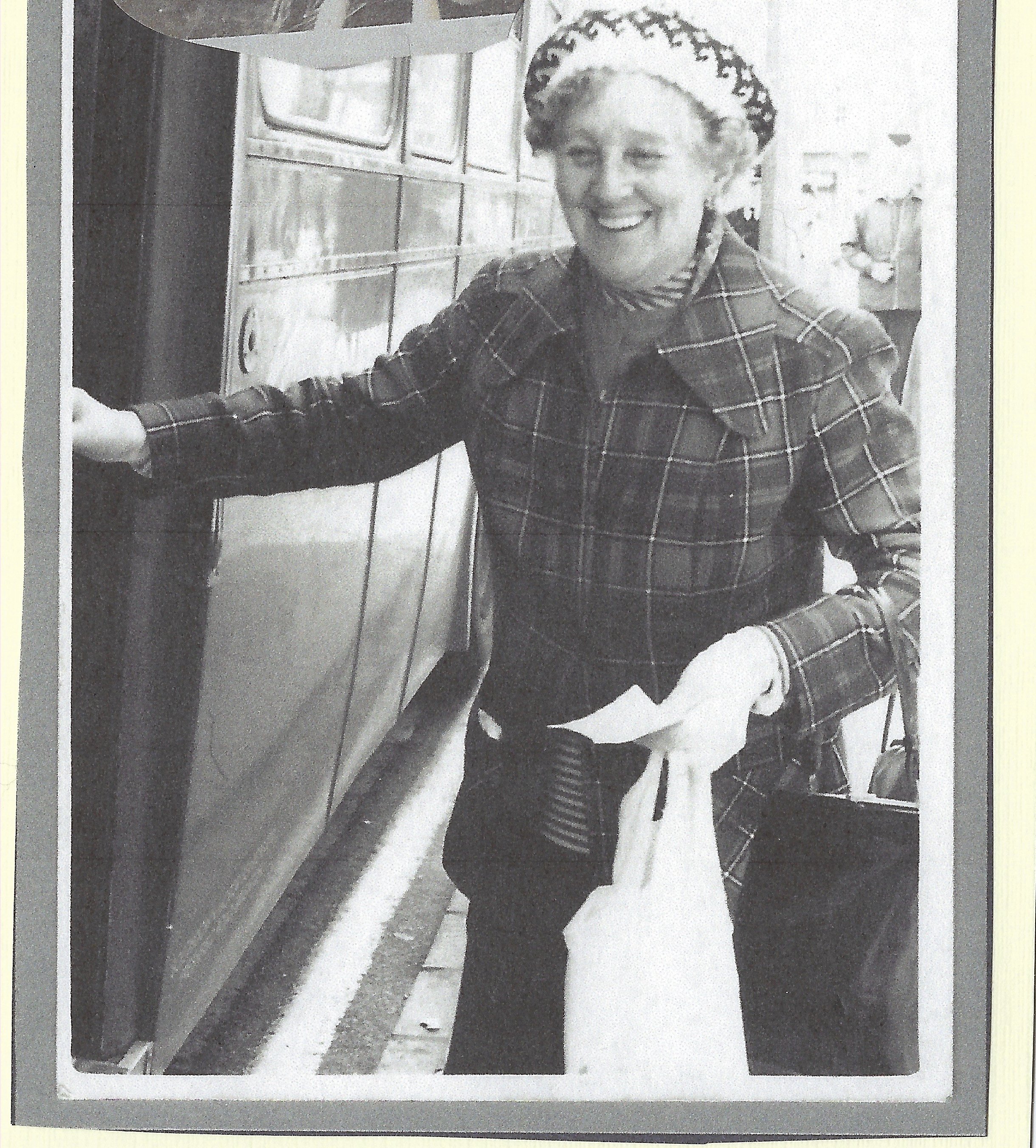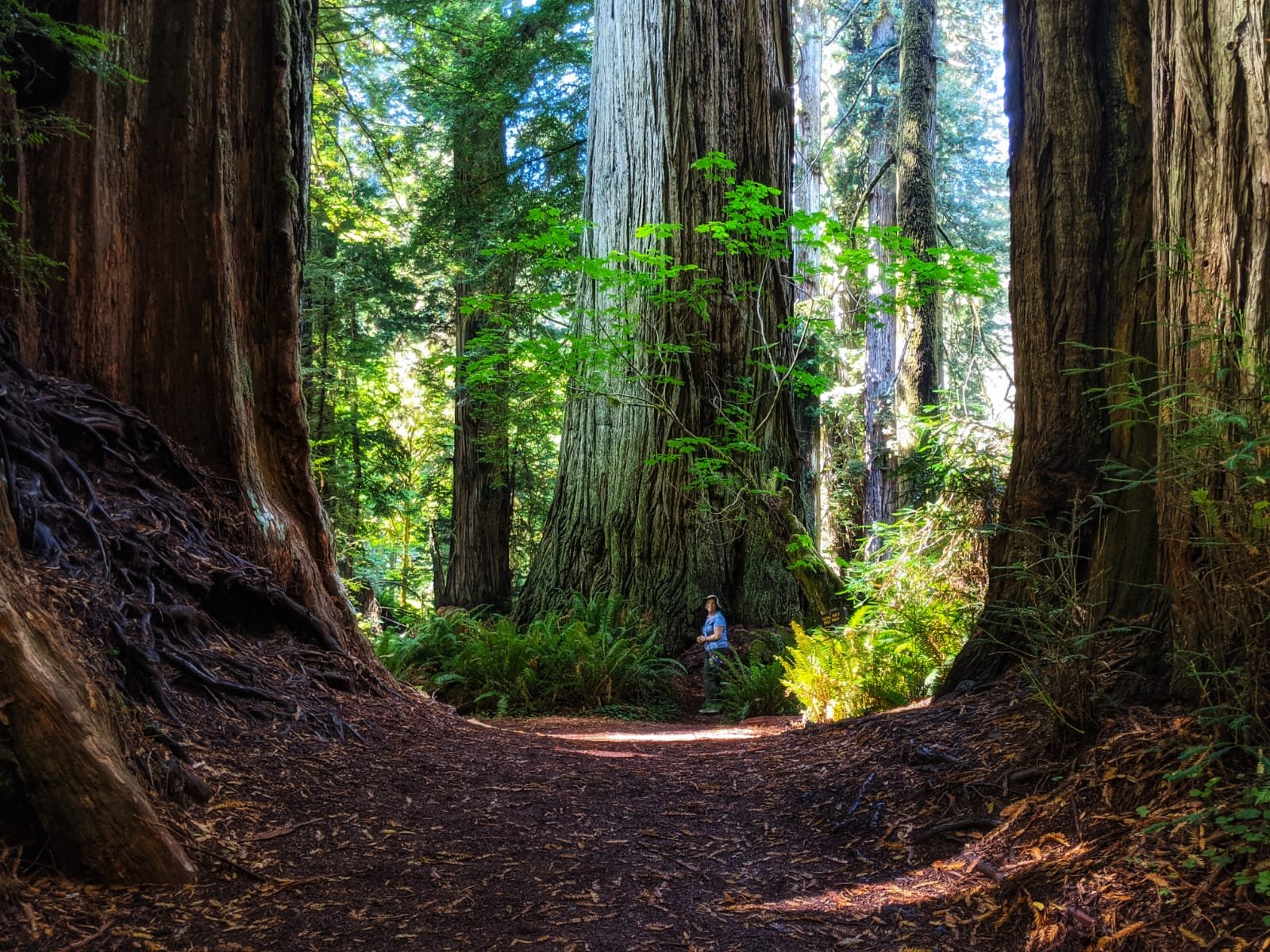The leaves on The Sister Trees shifted from the lime-green color of sherbet “ice cream” of my childhood to goldenrod & amber to releasing in mere days as we approached the time of year when the “veil” is thin, as if leaving room for arrivals and departures. photo by anne richardson
Settling Into The Cool, Dark Season
Those winds that whip the leaves off the trees predictably in November came in mid-October to the Pacific NW this year. You may have heard about the “bomb cyclone” off the Northern Coast of California that brought buckets of rain to soothe the drought for the time being in dramatic fashion. Mega-fire concerns replaced by mudslides and flooding. Yikes! A conga line of storms expanded up the coast to where I live. Yes, this drought parched region needed a thorough watering. But all at once? I promised myself I wouldn’t complain about the steady drip of rain until at least March and so far I’m keeping that promise. Check in with me next month as I seem to return from most walks somewhere between damp and sopping and may soon be growing moss behind my ears.
Dropping Into the Body
The moist, gray days are helping me settle and the restlessness I felt even a week ago is starting to fade. There is less urgency to “do.” When I settle, deeper voices from within begin stirring, murmuring. I drop down into my heart and gut and spend time waiting and listening. Listening even into my bones. I often find losses waiting to be grieved lingering in the spaces between the marrow. Losses my ancestors never grieved. Or Grief from the land of my origin whose “origins” are buried deep under a culture separated from the land on which they live. Those stirrings and murmurs are fragments of stories—mine and those before my own—frayed threads wanting to be woven back into a narrative…a healing narrative.
“bomb cyclone: a powerful, rapidly intensifying storm associated with a sudden and significant drop in atmospheric pressure”
A brief Grief aside: “Bomb cyclone” seems an appropriate metaphor for the intense losses some folks have shared with me recently. Perhaps the “bottom” has dropped out of your life and left you in the wreckage of a cyclone of loss. If so, please take the kindest care of YOU and reach out if you need support.
“The Veil.” Oregon Coast, summer 2021. photo by anne richardson
“Thin places” may feel like a fog, where there is a sense of a presence beyond our usual five-sensed way of “knowing.” Olympic National Peninsula, September 2020. photo by anne richardson.
Our Bodies As Holders for Grief and Trauma
The end of October, early November is a transitional time in the Northern Hemisphere. A threshold time. Known as Samhain (see Bits & Pieces/Odd & Ends below for more information) in the Celtic tradition, the tradition that I connect with ancestrally, it is when the veil between this world and the Otherworld is “thin,” like a scant fog or gauzy fabric.
Working in hospice for close to eight years, I witnessed folks who were close to death “seeing” or “talking to” those who were unseen by others in the room. For them the veil was thin. There are those who say it is “just the mind playing tricks” when these near-death experiences happen. Perhaps. We all have our own beliefs and comfort level with dying and what happens when we leave our embodied selves. What I can offer no matter your beliefs is this: we carry our ancestors in our cells. In our DNA. Their history resides in you. Those stories are etched beneath your story as it is being lived. A growing body of scientific research shows how trauma stories are passed along from generation-to-generation (epigenetics is part of this research.) Trauma lives on through the land too. And Grief is entwined in the trauma. Okay, that last one is my thought as the research is focused on trauma, but how can they not be entwined? I look with a spiritual and mystical lens even as the books and talks focus on mind-body connection and mental health…and then I try translating that into this work I offer.
So whether you believe someone saw their great-grandmother talking to them or not, perhaps their body recognized the person on a cellular level and in the “thin place” of dying. Something to consider whether you are firm on the “mind playing tricks” side or comfortable with less conventional thought. So here we are considering ancestors dwelling in thin places and in our bodies and how to begin a conversation with them, with ourselves, with the land. And…it is more complex when we consider collective trauma and other ways we pass along the complexities of past generations. And even how we define who our ancestors are. Just a little tidbit to ponder, if you want to join me…
Blocking Intuition By Trying Too Hard
In this thin-veiled time, as the nights lengthen. As I wait. As I turn to bone-listening and away from too much thinking, I look at my hands, where I can feel my bones, and ask, “Who’s there?” I touch my heart and say “What stories do you have for me?” I enter into sleep with intention to dream of ancestors and my dreams are muddled and no one arrives. Instead I dream my car is stolen (which I know also has meaning.) And so I grow impatient. I really want my dad to show up. He has not. He was not an absent father when he was alive, but he died close to 36 years ago and my grief for him has resurfaced. I want him to return. The scent of oil and grease on his hands after he worked on his car. His laugh when he did his silly monkey dance. The smile his eyes offered when I stopped by for a visit.
Or my nana. We had a strained relationship, but the more I read about trauma, the more my heart softens. What was her childhood like? What might she tell me? And on it goes. So many questions for so many ancestors. I believe I am trying too hard.
Listening to My Mentor Grief
And so I walk on dark mornings and listen instead to the wind and the leaves rustling. Rain falls on the hood of my jacket. These are my kin as much as my human kin. And they are wise. It is here Grief talks to me as mentor and Wind as companion. It is here they offer these insightful (to me) thoughts on Grief I want to share with you:
Concepts, theories, and beliefs need context for additional understanding. The “five stages of grief” which Dr. Elisabeth Kübler-Ross applied to those dying, arose in the early 1970’s, (her seminal work “On Death and Dying” was released in 1969) a time when the United States was going through a lot of upheaval. Looking for order out of chaos. We were also becoming more and more automated and “production” oriented. To have an orderly way to “get through grief,” which is what her work was translated into, a “fix” for the “broken,” it seemed to be an answer. Whew. Except it wasn’t and isn’t. I still shake my head when I hear the “five stages” worked into pop culture. “Which stage of grief are you on?” written into a commercial about losing out on some inane product, but “purchase this app and that will never happen again”. Sigh. Perhaps I am off base on this, though it is my gut sense based on my experience. So tell me, have you “worked through” the five stages and felt complete afterwards? Perhaps having the five reference points were helpful (I won’t deny that they can be for some) but did they also bind you in a way? Let me know, please.
Grief as an Archetype
As I listen more and more deeply to my Mentor Grief, I come back to this: Grief is an archetype, like beauty, joy, sorrow, love, pain, sacredness, the labyrinth. Something beyond defining. Sure, you can look in a dictionary and see “grief” defined, kinda. But will it be what you are experiencing? Archetypes, as I’ve learned from my studies with Dr. Sharon Blackie, are beyond our human construct. They shift and evolve and are perceived in our psyches as we as humans shift and evolve through time. We see our attempts to represent these archetypes in art, poetry, ritual, and other meaning-filled ways we connect, but no one way says, “ah yes, that’s it” to everyone.
My nana (paternal grandmother.) Stories she didn’t share…I wonder where they linger in my bones? Photo from the family archive.
“Five stages of Grief”—nice and orderly. At least that is what some would like us to believe but has never been my experience. photo by anne richardson
Moving Grief From Thinking Back To Embodiment
What the “five stages” did was move Grief from an embodied experience into a thinking concept. What the Grief archetype does, at least in my pondering, is move it out of the mind and back into the body. Poetry, which is my passion, is something that awakens those losses that have been slumbering. But it can also be done in noticing the decay of autumn. Through dance. A community lamenting together. A song sung in a minor key. Grief meanders through our bodies in many ways if we are awake. If we are awake, Grief will hold our hand…or simply hold us when we need to rest. Like the bone-listening where I find my losses resting. Waiting. It is also wise to remember every culture will engage with this archetype differently. Like walking a labyrinth, there is no right or wrong way.
Goldfinch visiting the birdbath. Part of a flock that are first time visitors to my deck offering much delight. photo by anne richardson
************
So that, my friends, is where I am these days. Impatient. Pondering. Waiting. Listening. Grieving. I could write more (about how the non-linearity of time increases the complexity of the ancestor relationship and Grief, our kinship with other beings that grieve, and just how expansive can we define “ancestors?”) but I will spare you for now as it still feels very disjointed and needs more time to stew.
Gratitude
In my experience I know I am right where I need to be, whether or not my ancestors call from behind the veil…or through my dreams or my bones. Soon I will be with family as we celebrate my niece’s wedding (and I am officiating. That is Joy!) And then a personal retreat for a few days by Mother Ocean where I will sink further into the season. Oh, and so grateful. Grateful for Wind. Rain. Vivid autumn colors. A flock of goldfinches visiting my deck for the first time. The gift of offering the work I do in the world. The gift of you.
I hope it is not two months before I blog again…but no promises. This season calls for drawing inward.
in deep gratitude,
anne
ps-I sit on these posts a day before I send out. Double check so I only miss 50% of my errors (lol.) Well, last night I dreamed I was attending a movie called “air” and/or “breathe” with my mom and some other vaguely familiar people. So a peak behind the veil with a message…
For Your Reflection
Look at your hands or another part of your body where you are “close to the bone.” Who do you see? Do you have questions for them? Write them down or say them out loud. What losses are lingering in your bones…yours or from past generations? Touch your heart. What do you feel? What threads are ready to be woven into a healing narrative on your journey? Take five minutes and write whatever is stirring. Or draw, collage, dance…whatever creative expression is speaking to you.
As I continue to meet with folks on their Grief journey and ponder more deeply my own losses, I am expanding my beliefs about Grief and discarding some old ones, as I shared above. Do any of them resonate with you? Do you want to push back against any? What do my thoughts stir in you? I would love to hear your ponderings.
Oh my, the traditional Western holiday season is approaching with all its expectations at what feels like an accelerated pace. What feelings does that stir in you? Anything you would like to not do this year that you have done in the past? What does “giving yourself permission to say ‘no’” look like to you? The invitation is to write a list of what you would like to say “no” to this year. And then what do you want to say “yes” to?
What questions do you have for your ancestors? Through my studies I have come to believe that our ancestors are always with us and one source even said “we are our own ancestors.” An interesting concept. If you could sit and have a meal with an ancestor, who would you sit with first? Where would you be? What might the meal include? What wisdom might you hope to glean?
What land(s) do you come from and what might those land(s) want to say to you? If that feels overwhelming, perhaps focus on a tree, bird, stream from that land.
If you were offered the “Five Stages of Grief” (denial, anger, bargaining, depression, acceptance) as a roadmap to help you cope with your loss(es,) what was your process like working with them?
How are you taking care of yourself these days? Are you being kind and gentle to YOU? Compassionate? Tender to yourself and others?
Bits & Pieces/Odds & Ends
Because she describes it so well and offers ways to be in this “thinly veiled season,” I’m sharing from Sharon Blackie’s latest newsletter about Samhein: Dreaming the dark
”The native traditions of these islands [Ireland, Scotland, Wales, England] tell us that, at Samhain, the veil between the worlds is especially thin. We are more likely, during this most liminal of all the seasons, to encounter the Otherworld(s) in its many manifestations. And so this time of year is perfect for deepening our practices to cultivate the mythic imagination, and explore the imaginal world. Our dreams can be especially potent during the season of Samhain, and our ancestors believed that they could offer us guidance, and in some cases, could be prophetic. It was believed, for example, that on Samhain eve you might dream about the person you'd eventually marry.At this time, the old folk traditions say, our ancestors too are more available to us – and especially in our dreams. Samhain is a time when many people report dreams that are more vivid than usual – particularly dreams of ancestors, or of loved ones who have recently died. Dreams of dead loved ones constitute some of the earliest written accounts of dream life. Classical writers and philosophers like Aristotle and Lucretius wrote about them, and of course it's no coincidence that in Greek mythology, Thanatos (the personification of Death) and Hypnos (the personification of Sleep and Dreaming) were brothers.
Today, those dreams are called 'visitation dreams' by researchers. dreams often have these features:The dream feels hyper-real: more intense and sharply focused
The dreams are less confused than 'normal' dreams
The dreamer feels strongly that the person is really there, rather than just an evoked memory
The dream consists solely of the interaction between the dreamer and the figure of the deceased person
Strong emotions are often reported: usually positive – love, forgiveness – but sometimes anger or fear
The deceased dream figure often looks younger and healthier than they did around the time of their death
The deceased often reassures the dreamer in some way – usually without actual words
The dreamer is often changed by the experience: some kind of resolution, or a sense of 'completion' of the grieving process
This Samhain, think about incubating ancestral dreams. One of the most effective ways to do this is to think of a very simple question, and hold it in your mind as you fall asleep. You can simply ask something like, 'What guidance do my ancestors have for me at this time?', or you can ask a specific ancestor for help, or for the answer to a specific question.
(If you're in the southern hemisphere, you're in the season of Bealtaine – the beginning of summer – when our ancestors believed the veil between worlds also to be thinner than usual. This is also a good time to incubate such dreams.)”
I’ve mentioned the book, The Body Keeps The Score. Brain, Mind, and the Body in the Healing of Trauma by Bessle Van Der Kolk, MD. Here is an article that summarizes it nicely: The Science of How Our Minds and Our Bodies Converge in the Healing of Trauma, found in The Marginalian, a weekly newsletter you can signup for free. It offers a variety of topics each week.
The Wisdom of Trauma community that is organized through SAND (Science and Nondualtiy,) completed a second week of showing the Wisdom of Trauma movie and offering “Talks on Trauma” series. They have released Climate Crisis, Fragmentation and Collective Trauma, A panel discussion with Dr. Gabor Maté, Bayo Akomolafe, Angaangaq Angakkorsuaq, & Eriel Tchekwie Deranger for general viewing. It is giving me pause…a much needed pause, especially as I reflect on Grief and my ancestral lands and how I embody that.
My poem, Snag, that was online through Tiny Seed Literary Journal blog is now one of the poems included in Anthology Forest, available through Tiny Seed’s bookshop. 50% of all proceeds will be donated directly to the reforestation project - Arbolution Oaxaca!. Cost is $12. If this appeals to you please support and receive a book of wonderful poems. (And yes, I get the irony of printing books to support reforestation.)
And here’s a poem to contemplate as you consider all who reside within. As I reread this poem, I found myself receiving it in a whole different light. Love After Love, by Derek Walcott.
The time will come
when, with elation,
you will greet yourself arriving
at your own door, in your own mirror,
and each will smile at the other’s welcome,
and say, sit here. Eat.
You will love again the stranger who was your self.
Give wine. Give bread. Give back your heart
to itself, to the stranger who has loved youall your life, whom you ignored
for another, who knows you by heart.
Take down the love letters from the bookshelf,the photographs, the desperate notes,
peel your own image from the mirror.
Sit. Feast on your life.
Bonus-How Do You Refresh?
I spent time away in September with my beloved to refresh and be next to kin: the timeless Redwoods and Mother Ocean (along a different shoreline—Northern California/Southern Oregon Coasts.) It was food for my soul. Where do you go and/or what do you do to refresh your soul?
At home with kin. (Yes, I am in the photo. Standing by hundreds-of-year old redwoods offers perspective.) California Redwoods State Park. September 2021. photo by David Bardes
Witnessing Mother Ocean’s Power. Northern California Coast. September 2021. photo by anne richardson













